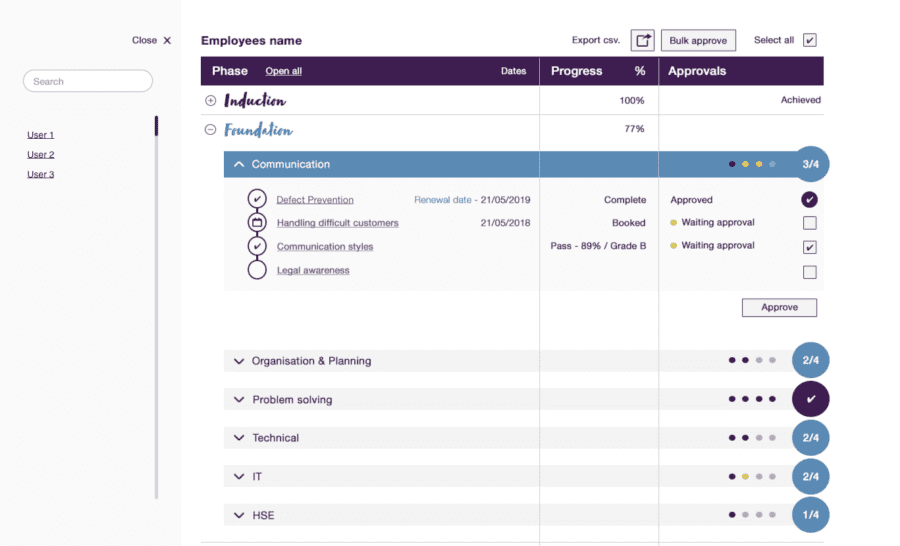Have you ever wondered how brands like Apple, Starbucks, and Netflix manage to achieve worldwide recognition and success? The secret lies in their global strategy.
A Learning Management System (LMS) is an application that helps organizations manage tasks in the area of learning and training. For example, such tools help in the administration, documentation, tracking, reporting, and delivery of educational courses, training programs, or learning and development programs.
Today, LMSs are essential for organizations that rely on employees to have shared, organized, and accurate knowledge about products, processes, and workflows in use.
Read this article to find out how your business can benefit from a custom Learning Management System.
Why use a Learning Management System?
All employees need to be educated and share the same level of knowledge about the company’s products, philosophy, values, processes, and customer support standards.
You’re probably thinking: “But we have a knowledge base, so people can find whatever they need.”
They sure can find information, but will they want to? Reading a massive amount of knowledge base articles that are often outdated and irrelevant isn’t something employees are happy to do.
Also, your staff may assume that what they already know is enough to do a good job. So why would they look for more information? Being lazy (optimizing for free time) is part of human nature.
Learning Management Systems (LMSs) will guide employees through a training program that checks off all the bits of knowledge that the team considers critical for the business. On top of that, it’s an interactive tool that not only displays the learning materials but also requires users to submit answers to quiz questions, pick the right answers, play minigames that check their approach to common problems, etc.

After completing the program, every team member will have the same base knowledge and a good understanding of what they need to work on if their score was lower than expected in some areas.
Sometimes, poor training scores can be used as part of the review conversations. High scores, on the other hand, will be helpful when choosing employees for promotions or/and bonuses.
Why invest in a custom Learning Management System?
Naturally, Learning Management Systems come in out-of-the-box versions. It’s always a good idea to review the options available on the market.
Note that out-of-the-box solutions come with specific disadvantages: Many of the existing solutions are more complicated than necessary. That’s because they’re designed to solve problems for ALL the clients who will be using them.
Also, when starting to work with such a system, organizations often need to adjust to their ways of handling the process, as well as to the types of training content that the system provides.
Building a custom solution offers a way out of this problem. A custom LMS allows organizations to:
- Fully customize the learning process and see the best results for their particular case,
- Match the system’s styling to the overall look of other systems, so team members instantly feel at home and don’t need to spend time on learning the specifics of the new UI,
- Add all the required integrations with other internal systems easily,
- Create user roles, levels, and responsibilities to match the organization structure,
- Keep all the employee data, materials, and sensitive information within a self-owned system,
- Simplify LMS administrator training – a custom system does not require them to understand all the many options which the company isn’t going to use anyway.
Additionally, organizations can use the same process with the custom platform to offer training to their customers – for example, during product onboarding.
Is a custom LMS the right solution for your organization?
Here’s a short answer: It can be.
Here are some things you should consider when planning to build a custom LMS:
- How often would you need to have your knowledge base re-evaluated or refreshed? In dynamic, innovative, and rapidly-evolving companies, that should often happen to keep everyone on top of changes.
- How many people will go through training on a monthly basis? This is a difficult question. Most of the time, 20+ people is a good starting point. For example, your sales reps, customer support, account managers, project managers and marketing department will always be among the first candidates for training.
- How critical is keeping all the staff in sync with the changes and new knowledge generated in the company? In some cases, there might be a lot of people in the company, but only a few of them should be informed. That’s especially true for production-oriented businesses.
- Do you already have a training program in place? If so, how effective is it? Do people like it or feel that it’s a waste of their time? What are your biggest problems?
- Does your organization have the budget for building a custom application? And does it have the resources to work with the vendor on nailing down all the details of the new system?
All the points above are important. I also know from experience that this type of project is a great way to wake up the innovation drive in organizations and involve employees in building a tool that will help them do a better job.
What you need to introduce LMS to your team
The process of implementing LMS is fairly straightforward, but it takes some time. Here are the typical phases of LMS implementation:
1. Discovery & training content
All department heads get together and decide on subjects they need to have covered in the tool. Each department works internally to come up with the training materials, questions, surveys, and others to work in their domain.
Note: If you decide to outsource the LMS implementation, a reliable vendor will facilitate these discussions and offer guidance on how to create good training content.
At this point, general decisions are made. For example:
- Who gets trained?
- What are the levels of training?
- How is training rated?
- What are the notifications delivered by the system?
- What reports are needed?
2. Project planning
Having all the content ready, now you can design all required features of the new system.
That includes planning the required marketing platform integration with other internal software as well. For example, you can automatically send a poor score result to the supervisor or the HR department?
3. Solution implementation/programming.
4. Launch
The best way to launch such a solution is by starting with a beta version used by a subset of users (for example, in a specific department). As they use the system, they can report issues and/or suggest improvements. Then comes the moment of the final release of the tool for the entire organization.
Summary
Building a custom Learning Management System is in the best interest of your organization. The limitations posed by out-of-the-box solutions don’t balance out their price, which might initially seem lower than custom systems.
However, by developing a unique solution for your organization, you can be sure that its structure and contents match your team requirements perfectly. And that’s what every learning tool should aspire to.
Are you interested in building a custom LMS project? Find out more about our Custom Software Development offer.






